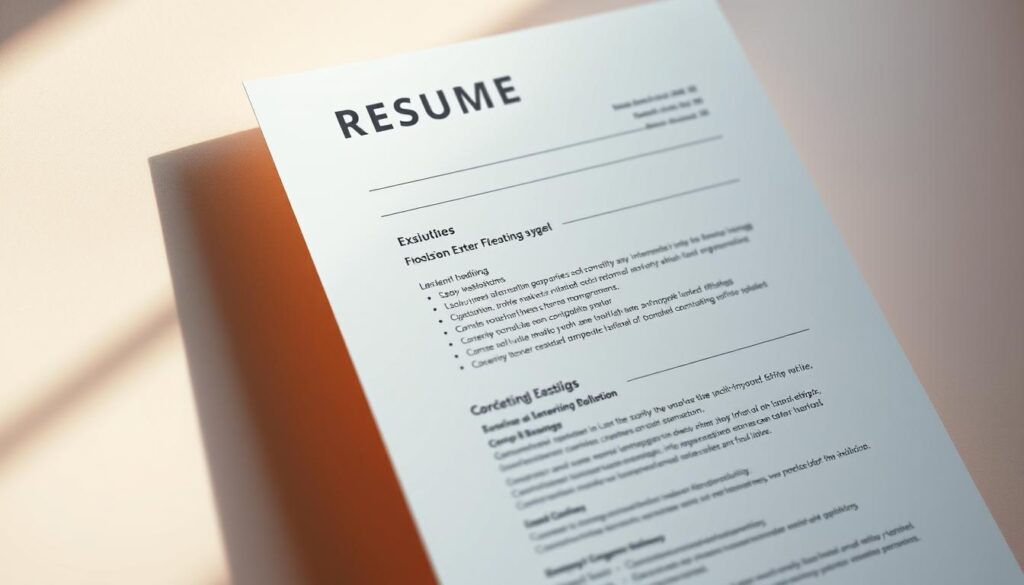Anúncios
resume mistakes to avoid are small details that change whether you earn a call or get passed over.
Your document is a focused pitch for today’s U.S. job market. Recruiters scan pages in about 7.4 seconds, and many companies use ATS filters that misread graphics or odd headings.
That means clear, single-column layouts and standard headings help both people and systems read your information fast.
Think of this as editing, not rewriting your life story. Tight language, relevant keywords from the posting, and short outcome statements (for example, “Reduced delivery time by 22%”) show impact quickly.
Below you’ll find a list-style guide that points out wording issues, irrelevant experience, and weak results — plus practical steps you can adapt for your career level and target company.
Anúncios
You won’t get promises here — just realistic tips you can apply now to improve clarity and increase your chances in interviews.
Why resume mistakes to avoid matter right now
Hiring teams and software now skim applications in seconds, so every line must pull its weight.
Employers and applicant tracking systems screen many resumes fast. That means each word and piece of information should point at the job you want right now.
A generic document often sinks. Tailoring your content so it mirrors the job description helps parsing and shows clear fit.
Think of a resume as one step in a larger process. A targeted cover letter and active networking reinforce the same story. They make your application more memorable.
“Precise, recent examples from the last few years matter more than long lists of old roles.”
Keep a clean master file and make focused versions for each posting. A one- or two-page format with tight wording helps people grasp fit in seconds.
- Match language to the job description for better parsing.
- Highlight outcomes from recent years.
- Let your cover letter and contacts echo the resume message.
For an actionable checklist, see common resume errors.
Beat the scan: recruiter attention and ATS realities
Dive into structure that helps a person and a parser read your file in one quick pass. You need short labels, scannable bullets, and front-loaded relevance so a hiring team spots the fit fast.
What 7.4 seconds means for each section
Place one clear outcome at the top of each entry. Use strong verbs and numbers so the first lines show impact.
“Make the top of each section earn the next second of attention.”
ATS-friendly formatting
Use a single-column layout with standard headings like Summary, Work Experience, Skills, and Education. Avoid graphics, icons, tables, and text boxes that scramble parsing.
Mirror the job description
Copy exact phrases from the job posting when they match your skills—examples: AWS, HIPAA compliance, Lean Manufacturing. That improves parsing and relevance for an employer and applicant tracking systems.
- Front-load measurable results in the first line of each entry.
- Keep consistent formatting and one clear outcome per section.
- Save the file type asked for by the company (.docx or PDF) and check the file name and contact fields.
Content pitfalls that hurt credibility and clarity
A single typo or conflicting title can make a reviewer question everything on the page. Small errors in a word or date change how a person reads your information and can lower trust, especially for roles that handle safety, documentation, or regulated work.
Typos, grammar, and inconsistent details: simple errors with big consequences
Even a misspelling like “manger” instead of “manager” suggests carelessness. Busy layouts and inconsistent fonts make it hard for someone and an ATS to parse your work.
Outdated objectives vs. concise professional summaries that add value
Replace vague objectives with a tight summary that names the job, lists core strengths, and gives one strong result. For example, swap “Responsible for inventory” with “Cut stockouts 18% by implementing cycle counts.”
- List responsibilities briefly, then add outcomes under each line.
- Proofread: run a tool, read aloud, then ask a human reviewer.
- Keep dates, titles, and company names consistent across your documents.
Prioritize recent, relevant experience and tidy formatting so reviewers focus on results, not sloppy layout. Small fixes make a big difference in credibility.
Relevance over history: tailor your resume to the role
Match what you list to what the employer asks for so people and systems see the fit fast.

Research 3–5 job postings in your target field. Pull repeated terms, tools, and certifications and save that list. Use exact phrases from the job description in your summary, skills, and work experience sections.
Align skills and tools with industry language
For Healthcare use terms like ICD-10, EHR, and HIPAA compliance. In Tech, list Python, AWS, Agile. For Manufacturing, add Lean Six Sigma, CNC, or preventive maintenance.
Curate recent, related experience
Focus on the last 10–15 years of work. Lead with entries that best match the job posting even if the title differs.
Translate transferable strengths—scheduling, vendor communication, stakeholder reporting—into role-specific phrasing you found in listings.
“Put the most relevant outcome at the top of each entry so reviewers see impact in seconds.”
- Research multiple postings and map shared skills and terms.
- Show matching experiences and trim unrelated history.
- Align responsibilities and outcomes with what the employer emphasizes.
- Handle gaps briefly: list certifications, recent projects, or freelance work.
- Mini-checklist to avoid common mistakes avoid: remove vague claims, irrelevant details, and mismatched terminology.
Tailoring respects the reader’s time and raises both ATS visibility and human relevance. Make edits that keep your career story honest and focused on fit.
Show impact, not just activity
Make every bullet answer: what changed because you acted, and by how much? Start each line with a clear action verb and lead with the number when possible.
Replace responsibilities with achievements that show results
Turn duties into accomplishments by pairing an action with a metric. For example: “Reduced freight costs 12% through carrier negotiation,” or “Cut delivery time 22% by reworking routes.”
Quantify outcomes with data and action verbs
Use verbs like led, implemented, streamlined, automated, and optimized. Measure impact beyond revenue—time saved, error reduction, SLA gains, and adoption rates all count.
Prove soft skills with examples, not lists
Show leadership with a result: “Mentored five technicians; cycle time improved 18% in six months.” That demonstrates teamwork, coaching, and measurable progress.
“Prioritize 3–5 bullets per role and use dashboards or reports to estimate figures honestly when exact numbers aren’t available.”
- Keep your work experience focused on the biggest outcomes.
- Align each accomplishment with the job priorities you target.
- Follow one clear step: find data, pick the strongest wins, and write numbers-first bullets.
Length, layout, and consistency that help you get read
Choose length and structure that present your work clearly and match the job you want.

One page for early career; up to two pages for experienced professionals
Early-career candidates with 0–5 years experience generally fit on one page. If you have 5–10+ years or deep, relevant achievements, use up to two pages.
Clean, single-column layouts with clear sections recruiters expect
Use a single-column format and standard headings. Keep fonts, spacing, and bullet style consistent. Limit bullets per role to 3–5 so each section reads fast.
Align LinkedIn titles, dates, and keywords with your resume
Place your most important skills near the top and show them again in accomplishments. Match job titles and dates on LinkedIn with your resume and update fields when a job posting uses different language.
Quick check: does each section advance your story, and does every line earn a spot on the page?
- Do use plain language an employer and an applicant tracking system recognize.
- Don’t include graphics, tables, or columns that break parsing.
- Do tailor descriptions and skills to the job posting and company needs.
Conclusion
Small, honest edits that highlight recent results often change whether employers pick up the phone. Focus your summary, quantify one clear example, and match key skills to the role you want.
Keep your work experience and history centered on the last 10–15 years and summarize older items briefly. That boosts relevance for an employer and improves how resumes perform with ATS and people.
Take one step today: tighten a summary line, add a number to a bullet, or align a skill with a job posting. These moves build momentum without promising interviews.
If you can, get feedback from a mentor, career service, or coach. Adapt examples to your industry and company size, and use your cover letter and networking messages to echo the same action-oriented story.
Consistent, focused iterations turn a good resume into a clear, confident story that earns more opportunities to talk.



